Circumstances of the injury event
This section presents information relating to the initial TBI admission on the:
- external cause of the injury
- activity being undertaken at the time of the injury
- place where the injury occurred.
External cause
The major cause of injury is recorded in the NIHSI AA using an external cause of injury code from the ICD-10-AM. The two most common causes of initial TBI hospitalisation in the cohort were falls (over 9,000 cases; 39%) and transport crashes (over 7,300 cases; 31%), followed by assault (almost 2,900 cases; 12%) (Figure 6; Table S3).
Figure 6: Number of cohort patients by external cause of initial TBI hospitalisation and sex
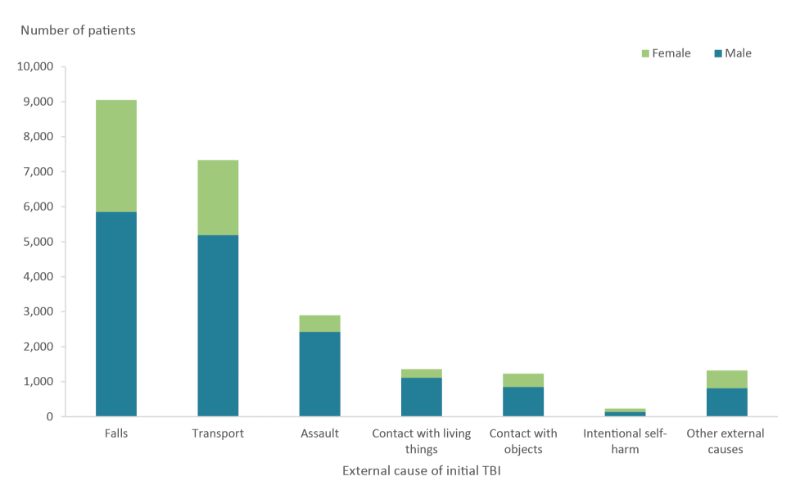
Notes:
- Excludes 21 records where external cause was Not reported.
- Contact with living things includes unintentional person-to-person contact, such as while playing sport.
- See Technical notes for external cause ICD-10-AM codes.
Source: AIHW NIHSI AA v0.5.
External cause by age
TBIs caused by falls were most common in the 0–14 age group, followed by the 55–64 age group (Figure 7; Table S4). TBIs caused by transport, assault, and contact with living things were most common in the 15–24 age group.
Figure 7: Number of cohort patients by age group and external cause of initial TBI hospitalisation
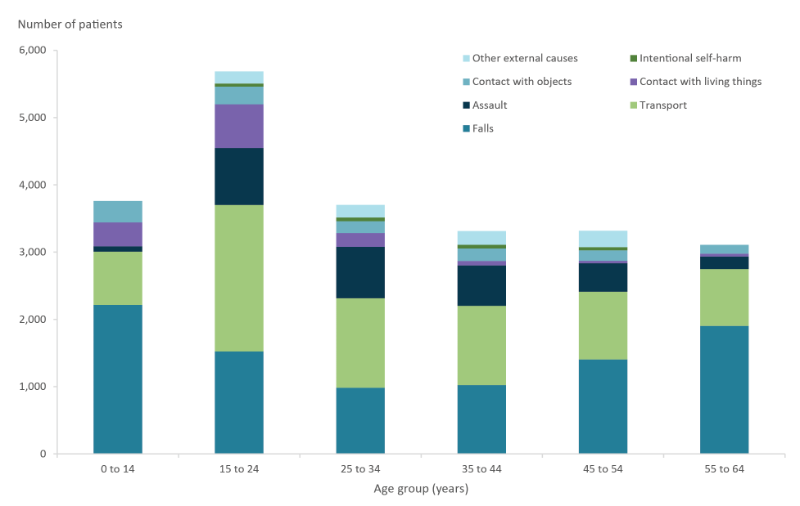
Notes:
- Total includes 21 cases where external cause was Not reported.
- 166 records in the 0–14 age group and 372 records in the 55–64 age group whose cause is either Intentional self-harm or Other external causes are not shown in the figure due to confidentiality concerns.
Source: AIHW NIHSI AA v0.5.
Activity when injured
Almost one-fifth (19%; 4,500) of the cohort reported that they were engaged in sport when the TBI occurred and 6.9% (over 1,600) were doing paid or unpaid work. Among people playing sport, almost 1,800 were playing a type of football (Figure 8; Table S3) (see also Table S4).
Figure 8: Top activities being undertaken when initial TBI occurred
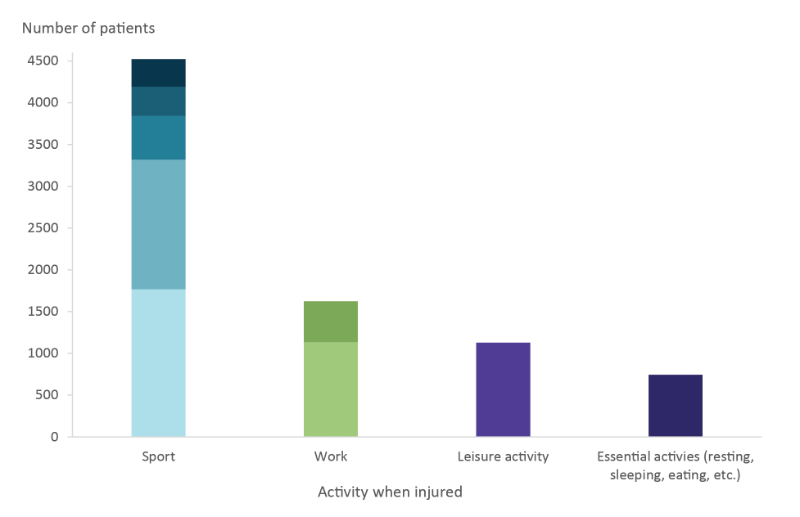
Note: Excludes 21 records where external cause was Not reported.
Source: AIHW NIHSI AA v0.5.
Looking more closely at the type of sports being undertaken when the TBI occurred, football (all codes combined, including Australian Rules, rugby, rugby league and soccer) was the most common sporting activity, followed by motor sports and equestrian sports (Figure 9; Table S3) (see also Table S4). The ‘Other sports’ category comprises TBIs sustained while engaged in a range of other sports (for example, ice and snow sports, as well as an unspecified sporting or exercise activity) (See Technical notes).
Figure 9: Number of cohort patients with initial TBI injuries recorded as occurring while playing sport, by sporting activity and sex
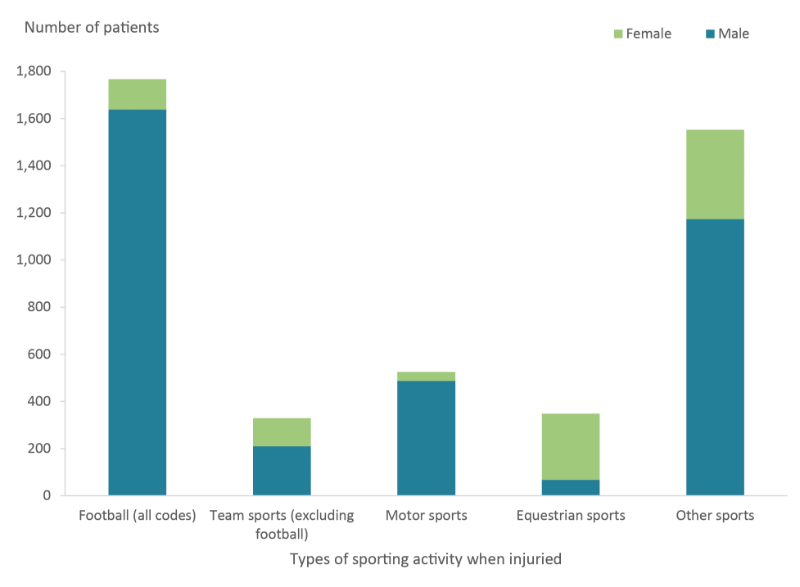
Note: ‘Other sports’ includes other specified non-team sports and unspecified sport and exercise activity. See Technical notes for further details.
Source: AIHW NIHSI AA v0.5.
Place of occurrence
Over one-fifth (22%; 5,100) of the cohort reported that the place where the TBI occurred was a street or highway and 17% (4,000) were at home and 12% (2,700) were in a sporting setting (Figure 10; Table S4).
Figure 10: Number of cohort patients by place the TBI occurred
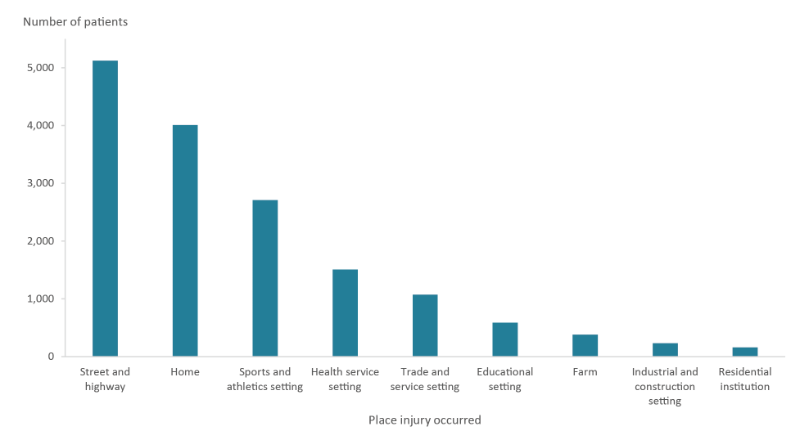
Note: There were also 7,648 patients whose injury occurred at another specified or unspecified place.
Source: AIHW NIHSI AA v0.5.
Looking at the top six places of occurrence only, Figure 11 shows TBIs that occurred in the home were most common in the 55–64 age group, followed by the 0–14 age group (see also Table S4). TBIs that occurred on roads and sporting settings were most common among 15–25 year olds. The number of TBIs that occurred in health service settings (such as hospitals, outpatient clinics and health centres) steadily increased with age.
Figure 11: Number of cohort patients by selected place TBI occurred and age group
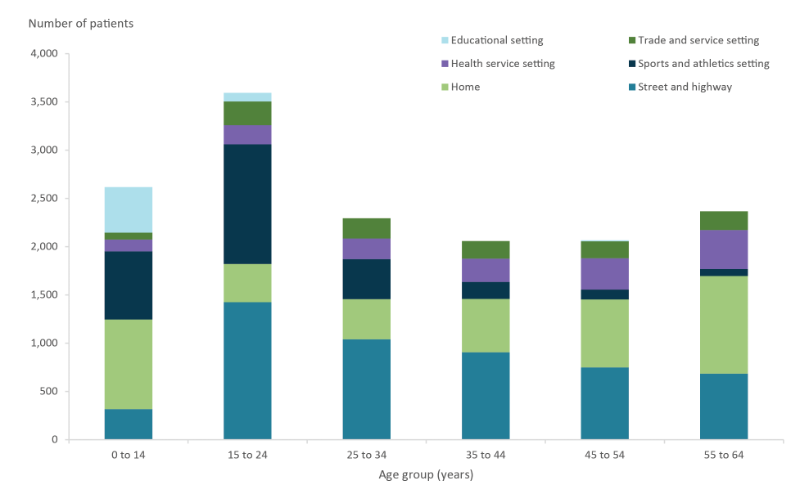
Note: 17 patients aged 25–44 or 55–64 whose injury occurred in an educational setting not shown due to confidentiality concerns relating to small values.
Source: AIHW NIHSI AA v0.5.


